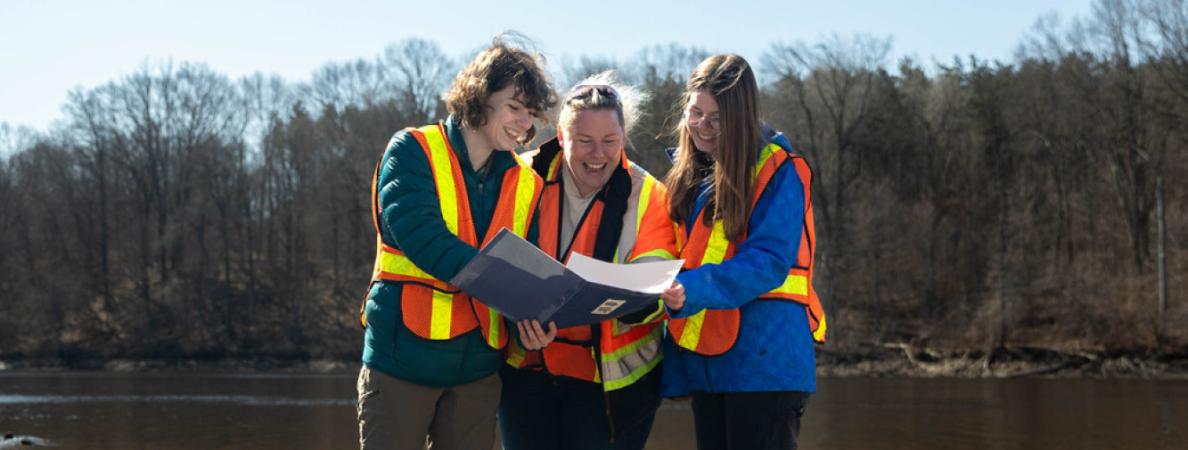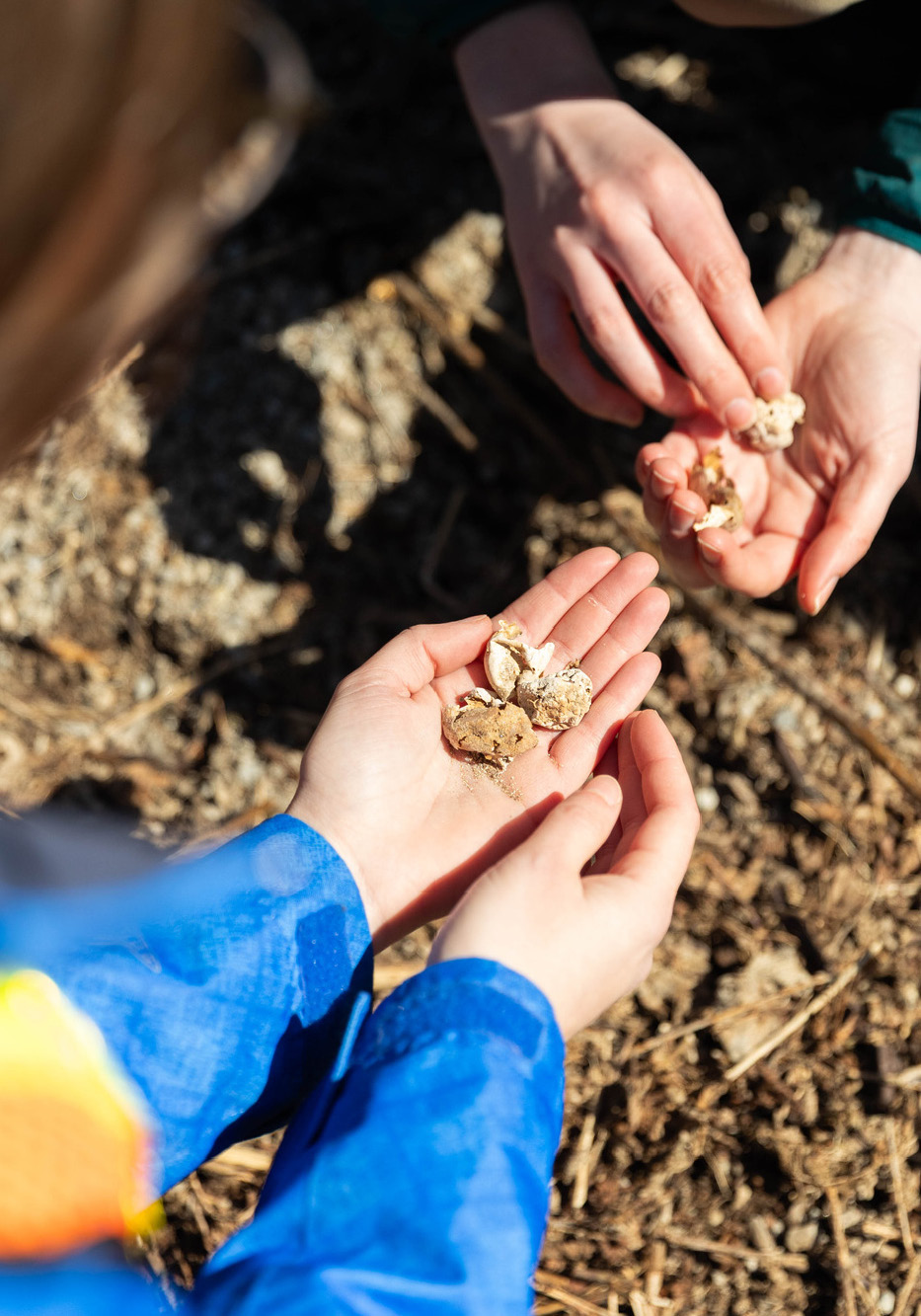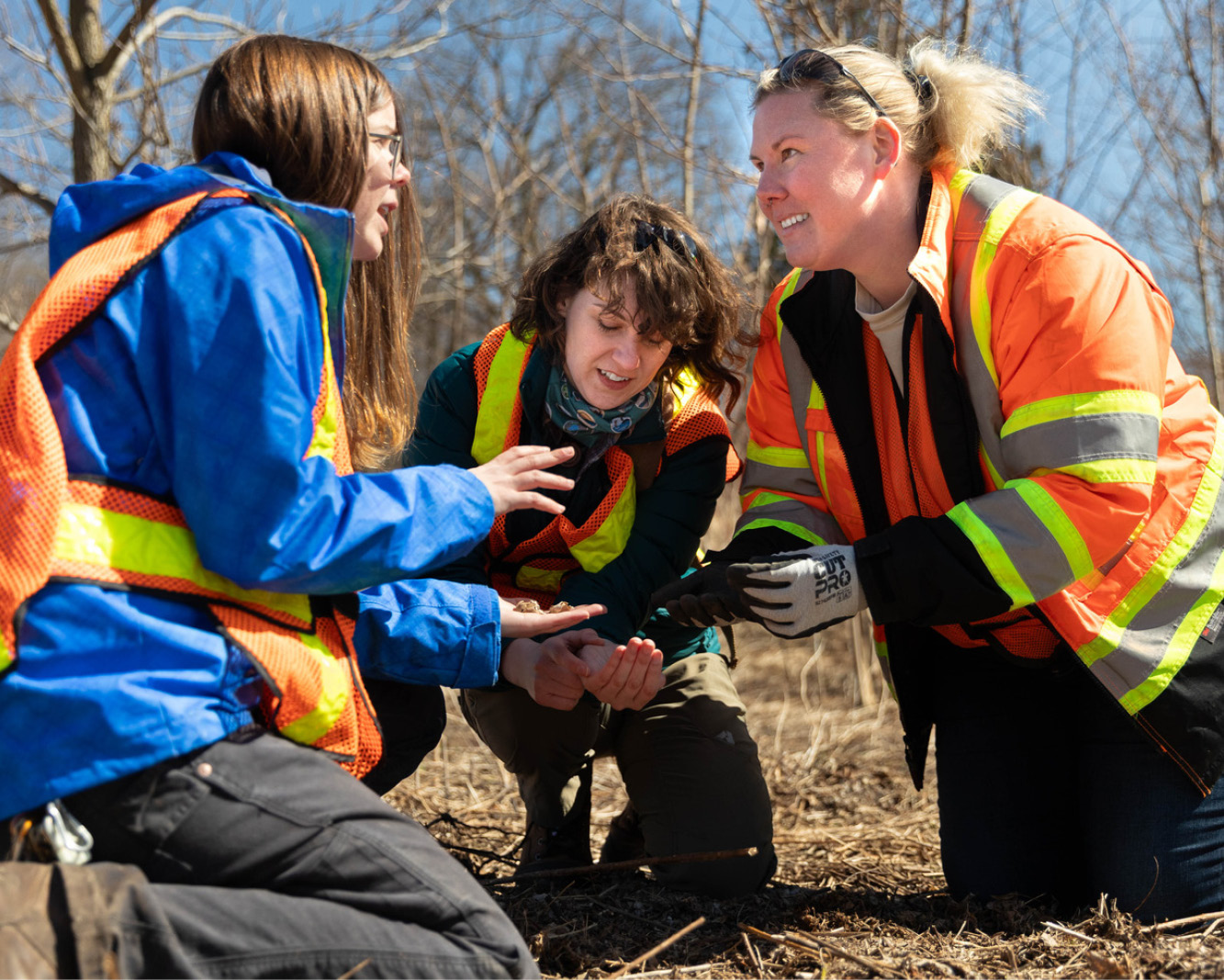
Not every turtle has the modern-day survival skills of Leonardo, Donatello, Raphael and Michelangelo. At a small lake in Dundas, Ontario, the snapping turtle population is declining, and they could use a little help from some soon-to-be environmental professionals and real-life heroes.
Meet the “Turtle Team,” Jori, KC and Madie. They chose to restore a snapping turtle nesting habitat at Christie Lake Conservation Area as part of their Environmental Capstone Project. Like many programs at Mohawk College, students in the Environmental Technician Diploma program learn how to bridge the gap between classroom theory and the real world. The goal of capstone projects is to identify a specific challenge and solve it through the application of knowledge and skills acquired throughout their program of study.
This project was about more than just building a habitat. They learned how to work effectively with industry partners like the conservation authority staff, follow safety protocols, and conduct vital conservation research specific to the site. It also taught them how to research, collaborate and understand the intricate connections within an ecosystem and apply Project Management fundamentals.
But why snapping turtles?
The decision to focus on snapping turtles came from a desire to help a local ecosystem. Madie highlighted the practical reasons for their choice: "With the population kind of on the decline and... so many turtles being hit [by cars]," the team wanted "to do something to rectify it on a small scale." This issue was particularly relevant at their chosen site, Christie Lake, where, as Madie explained, "a lot of the turtles will nest along the side of the roads, resulting in turtles being injured or killed."

Beyond addressing this direct threat, the team recognized the species' wider importance. KC provided the ecological context, explaining that snapping turtles function as "an indicator species... one of the hardier turtle species." Their resilience means their population trends offer valuable insights into the health of the entire ecosystem. As KC noted, "when we see their numbers declining, we can expect that other turtle species are declining too." Therefore, helping snapping turtles at Christie Lake became a tangible way to address a specific danger while contributing to a larger understanding of environmental well-being.
The role of a snapping turtle extends past being an indicator species. They are omnivores who eat carrion. In doing so, they actively contribute to the cleanliness and balance of the lake’s ecosystem. Jori explained that by increasing the snapping turtle population, it "will help keep the water cleaner because they eat dead animals and bacteria in the water. So they help keep it clean."
This active contribution, combined with their indicator status, underscored the value of the restoration project.
What’s involved in a snapping turtle nesting habitat restoration?
Getting started wasn’t easy. Winter made the initial site visit a challenge. "It was a long process to figure out the restoration process," Madie recalled, noting they first had to "come on site and actually see what we were dealing with." Winter conditions made this tricky. "It was a little bit difficult... we had a lot of snow this year. So, we had to dig through to see what was on that ground layer."
Once the snow melted, the team could begin the work of preparing the site. They needed to create a better alternative for sunning than the nearby road. They also needed to create a natural pathway for the turtles to use their nesting habitat.
The process involved removing obstacles to sunlight and nesting, including specific trees like a large Manitoba maple, unwanted shrubs, and extensive root systems. Identifying vegetation correctly in its dormant state required specific skills, focusing on "buds, looking at bark... Those are the key indicators rather than the leaf in winter," as Madie described.
Collaboration with Christie Lake Conservation Area staff was part of the success of this project, especially when they needed to borrow heavy equipment. Madie appreciated their help, noting they operated a front-end loader needed "to scrape the ground."
The work wasn't linear. It was what Madie called a 'step-by-step process': assess, act, reassess. This included loosening soil and adding materials like sand. The team also designed and built a nest cover, considering factors like "maximizing sunlight with the cover on, while still maintaining the integrity of the protection," and "allowing for as much movement as possible inside and creating little escape holes," Jori added.
Behind-the-scenes challenges
Not all the work happened in the field. In fact, KC mentioned how much of the project involved less visible, but equally important, tasks. "One of the biggest challenges was actually just the administrative tasks of... sending a lot of emails and making a lot of phone calls."

Effective data collection was fundamental. KC noted the value of information from a Royal Botanical Gardens (RBG) contact and data gathered via iNaturalist, which "helped us plan how to direct the turtles in the right direction."
The team also faced complex conservation and ethical challenges. Jori mentioned considering "predation... animal and human." Madie added that to limit potential poaching they avoid publicizing the exact site location. Jori framed it as a balance: "That's one of our struggles. Trying to decide how to mark the area to prevent public interaction. We don't want to encourage poachers; we don't want to draw attention to it." Yet, there's also a desire for awareness: "We want people to be more aware... spread the knowledge... in order to continue to help the species, which in turn helps other species... and also helps increase the sustainability of the ecosystem."
Learning and looking ahead
This capstone project deeply impacted each of the members of this group. It solidified classroom knowledge and built practical skills like site assessment, plant ID, and on-the-spot problem-solving, as Madie explained. KC found the program's scientific foundation, especially chemistry, unexpectedly valuable for understanding how "tiny, tiny changes... can affect an entire ecosystem."
For Jori, this project was the catalyst that cemented her passion. "It's a reason to wake up in the morning, and it's exciting to come out and... feel like I'm having a positive impact."
Madie echoed this sentiment: "We're passionate people... We want to dig in the dirt and say, 'look what we did.'... It's fun."
Future monitoring is planned to gauge the project's success by observing if turtles utilize the restored habitat.
Advice for future students
For the Turtle Team, this project wasn’t just an assignment, it was a deeply meaningful experience. Their advice to future students reflected the passion that fueled their work. KC emphasized the importance of building relationships: “Make community connections while you're at Mohawk... it’s just really vital for your career.” Madie underscored the value of commitment and heart: “You get back what you put into it."
Jori’s advice blended practicality with enthusiasm and encourages everyone to start now. “Get into the field early... get a job at your local conservation area... start paying attention to everything that's around you.” Jori also urged students to take the academics seriously: “Definitely take those chemistry courses. Definitely take physics... pay attention to your math teacher.” While often focusing on water and waste treatment, Jori pointed out that the Environmental Technician program “opens so many other doors.”
What tied it all together was a shared belief in the impact students can have. “If you are serious and passionate about climate change and sustainability,” Jori said, “Mohawk College is definitely the place to go.”
This capstone project is a testament to that spirit. It shows how drive, curiosity, and a commitment to the planet can make a lasting difference, one turtle at a time.
Explore climate-focused programs
Our sustainability and climate-focused programs help you combine practical experience with skill development and industry knowledge, equipping you to lead change in the green economy.




